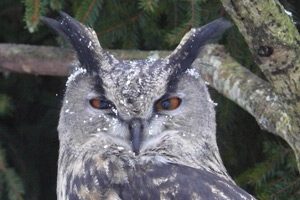Where do they live? Eurasian eagle-owl occurs mainly in old mixed and coniferous forests, along the sea coast, along the banks of the River Gauja, near lakes or other water bodies, as well as in city forests and near the largest waste landfills, which are rich in a high variety of food.
How do they live? The Eurasian eagle-owl does not make nests; they lay the eggs on the ground, most often - near tree roots in a small furrow or hole. They can also nest in tree hollows, sandstone caves and nests abandoned by large birds of prey (which is a comparatively rare occasion).
Eurasian eagle-owl is highly sensitive to interferences and can leave their brood, if they feel endangered. The number of eggs in the brood depends on the food base available in the surroundings. The young of the Eurasian eagle-owl are hatched with their eyes closed - the eyes only open after two days. The young leave the nesting site approximately at the age of five weeks old; they obtain the capacity to fly, when they are approximately 52 days old. Both parents care for their young until the age of 3- 4 months. In autumn, the young Eurasian eagle-owls leave their home for good in search of their own territory.
What do they eat? Many things! Their food base consists of mouse-like rodents, various small mammals (rabbits, hares, cats, hedgehogs, minks and other), as well as bird species (including woodpeckers, crows, partridges, ducks, geese, owls, birds of prey), as well as amphibians and reptiles, fish, insects and worms. Their hunt relies on excellent hearing that they exercise while sitting on a tree branch or other elevation, or, while flying over their territory. Sometimes they even hunt birds in flight.
Did you know?
- The hollow, monotonous call of the winter mating period can be heard as far as at a distance of 5 km. Eurasian eagle-owl can often be detected based on their voice. The flight of these birds is slow, very silent and low. By using air currents, they very seldom flap their wings.
- How do Eurasian eagle-owl differs from other owl species? The primary distinguishing feature of the Eurasian eagle-owl is its size - it is the largest strigiform bird in Latvia. It is characterised by the “ears” on their head – decorative feather tufts, large, orange eyes and brown spotted or yellow and brown spotted, camouflaging plumage.
- Common characteristics of owl family birds.
- Owls consume their prey, which has previously been killed with their sharp claws, in some safer place above the ground, for instance, on the branch of a tree. Smaller prey animals are swallowed whole (with feathers, hair, bones and claws), with their head first, while larger animals, as well as animals that are intended for feeding the young, are torn apart by their beaks. After digesting their prey, owls regurgitate - remains of undigested food bundled in clumps. If the hunt has resulted in too much prey, everything that is not eaten during one meal is hidden.
- All owls are far sighted and cannot see anything right in front of their nose – therefore owl beaks are surrounded by special sensitive feathers that they use to feel their prey. In contrast from diurnal birds of prey, owls have good binocular vision - the visual fields of both eyes overlap by 50-70%, while in other birds the overlap is only 30-50%. Owls can rotate their head in all directions by up to 270°.
- The ears of all owls are situated on the opposite sides of the head and are located asymmetrically.
- In moments of danger, all owls are capable of ruffling their feathers upwards, seemingly becoming larger and, producing hissing sounds in an attempt to frighten their attacker.
- All owls are characterised by the simultaneous laying and brooding of eggs. Due to this reason owl nests can contain chicks of different ages. If parents are short of food, they will raise and feed only one - the oldest chick. The stronger chick can often kill and eat their brothers and sisters. This is called cainism.
- All owls are predominantly sedentary birds and prefer residing in one particular territory. They are monogamous (usually - for life) and every spring, during mating time, they find their regular partner and commonly establish their nesting territory (it may change slightly every year, depending on the conditions).
- They find their prey with the help of their excellent hearing. Owls predominantly hunt and are active at night and dusk, and very seldom during the day.
- Only female owls brood the eggs, but both parents take care of chicks. The young owls leave their nest before they have developed their plumage, but they keep near it until completely matured.
- All owls are definitely considered to be a symbol of wit, knowledge and wisdom. In some cultures they are associated with death, moaning, magic powers and evil. Owls are often considered to bring messages from the afterworld, for example, news of the death of a relative.
A couple of Eurasian eagle-owls live at Līgatne Nature Trails.
 Līgatne Nature Trails
Līgatne Nature Trails
